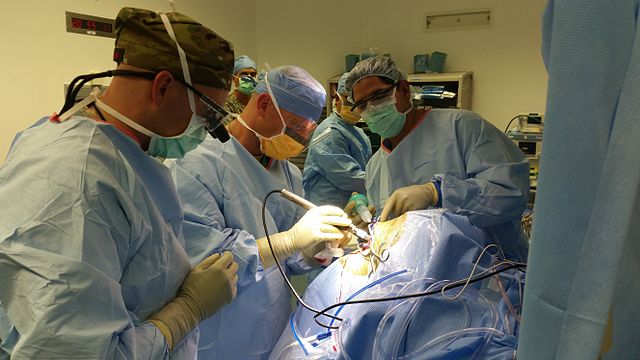What’s Next For Neurosurgery?
The past and present of neurological surgery in the midst of technological advancements and innovation through research.
Wikimedia Commons-U.S. Navy, Lt.Cmdr. Jesse Ehrenfeld, public domain
Neurosurgery requires focus and precision. Dr. Matthew Bradley, Chief of Trauma at the NATO Role 3 Multinational Medical Unit, performs an emergency neurosurgical procedure on a patient in Kandahar, Afghanistan.
The surgical treatment of brain, spine, and nerve diseases is the focus of neurological surgery, sometimes known as neurosurgery, such as aneurysms, brain tumors, spinal stenosis, hydrocephalus, and more. Neurosurgeons receive extensive education and training to become experts in the evaluation, diagnosis, and treatment of patients with a wide range of disorders affecting the nervous system and its supporting and surrounding structures that can be treated surgically, including minimally invasive, microsurgical, and standard surgical approaches. These disorders range from disc ruptures in the spine to brain tumors and aneurysms.
Neurosurgery became a recognized specialty in the early twentieth century. The removal of cerebral tumors and the correction of spine problems are both delicate procedures. Over the last two decades, neurosurgical technology has advanced, as it necessitates protocols to ensure that it is used efficiently and successfully. Today’s procedures include cerebral tumors being removed while minimizing tissue damage, preventing problems and morbidities, and improving postoperative conditions and patient quality of life.
Trepanation, or brain surgery, was conducted centuries ago by ancient healers and surgeons who drilled into the skull and tinkered with its contents with hand-operated drills and other instruments without painkillers and scalpels, which were not available at the time.
Trepanation, or brain surgery, was conducted centuries ago by ancient healers and surgeons who bored into the skull and tinkered with its contents with hand-operated drills and other instruments. Today’s procedures, on the other hand, feature modern amenities such as scalpels, painkillers, and anesthetics.

https://commons.wikimedia.org/wiki/File:Incan_brain_surgery.jpg)
There has been a significant amount of progress made in the field of neurosurgery, particularly as a result of the development of new technologies, from hooks and probes to even retractors, along with the ongoing progress that has resulted from research. The advent of minimally invasive neurosurgery, for instance, has made it possible to develop new robotic surgical tools and implements of nanotechnology.
Survival rates after neurosurgery are approximately fifty percent ten years after the treatment, making brain surgery one of the most dangerous procedures in all of medicine. Patients whose diseases have progressed to the point where they require brain surgery are already in very critical states. Therefore, research assists neurosurgeons in producing better outcomes for their patients by providing them with safer and more cutting-edge surgical options.
“We’ve been using navigation techniques in brain and spine surgeries over the last 15 years, and the robot is a natural extension of that,” Dr. Anna Terry MD, MPH said to the Eagle Tribune. “It allows you to place your hardware very accurately, building on previous technology we’ve been using for years now.”
Taking into account the reduction of errors and complications would result in less damage and greater efficacy in less time for surgeons. In addition to robot appendages, the rapid development of robotics will soon make it possible for neurosurgeons to control a full robot either in person or remotely. This line of thinking also brings to mind the idea of nanorobotics, which can be utilized in endovascular procedures affecting the blood vessels as well as the delivery of genetically modified drugs to diseased cells in the nervous system.
Due to the fact that the human brain is one of the least understood parts of the body, neurosurgery is at the forefront of medical advancement. In terms of both technology used for neurosurgical treatments and the understanding of the roles that our brains play in our bodies, there are a great number of problems that have not yet been satisfactorily resolved.
Both neurosurgery and neuroscience research demand a high level of precision, particularly in the planning and carrying out of an experimental protocol. The potential value of research, on the other hand, is the best that neurosurgeons can do in the operating room for their patients.
Neuromodulation, which includes altering the way in which the brain functions through the use of electrical stimulation in an effort to improve function, is one of the newest and most intriguing disciplines in the field of neurosurgery thanks to efforts of researchers. A growing number of illnesses, such as Parkinson’s disease (and other movement disorders), epilepsy, cluster headaches, and even psychiatric disorders, are being successfully treated using neurostimulation. Neuromodulatory electrodes can be implanted through surgery inside the brain.
With deep brain stimulation from neuromodulation, we are able to record signals from human brains, which provides us with a once-in-a-lifetime opportunity to gain a deeper understanding of how the brain functions and how we might improve the effectiveness of electrical stimulation. There is a possibility that in the future, electrical stimulation could be used to boost memory and intelligence. By implanting electrodes with deep brain stimulation procedures would create a new and growing specialization within neurosurgery.
As neurosurgery has gone a long way, there is much more to come to create a positive impact on patient outcomes when going through life-saving producers. With the future of neurosurgery underway, what is currently considered to be the gold standard in medical care was formerly part of a research study. Neurosurgeons treat patients now using the same methods that were researched yesterday.
There has been a significant amount of progress made in the field of neurosurgery, particularly as a result of the development of new technologies, from hooks and probes to even retractors, along with the ongoing progress that has resulted from research. The advent of minimally invasive neurosurgery, for instance, has made it possible to develop new robotic surgical tools and implements of nanotechnology.
Ryan Ahmed is a Managing Editor for 'The Science Survey.' He wants to uplift communities and provide unique insight on current events around the globe...











